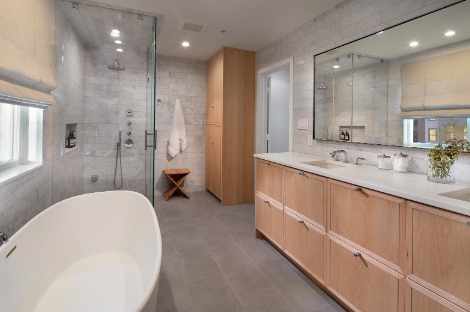 Planning is a crucial part of any home improvement project, including the bathroom. If you wing it, you will likely overspend and end up not being happy with the outcome. Instead, plan your budget, research various fixtures, and make a plan of where you want to begin the renovation. Then, when the time comes, you can start the installation process. Hopefully, these tips will help you enjoy the process and get the best results.
Planning is a crucial part of any home improvement project, including the bathroom. If you wing it, you will likely overspend and end up not being happy with the outcome. Instead, plan your budget, research various fixtures, and make a plan of where you want to begin the renovation. Then, when the time comes, you can start the installation process. Hopefully, these tips will help you enjoy the process and get the best results.
Before you begin the bathroom remodeling process, you need to make sure you know exactly what you want your new bathroom to look like. There are so many things to decide when working with limited space. From the layout to the fixtures, there is a lot to plan. You also need to plan the tile and design, as well as the style. Each step of the process has its own set of individual tasks that you must complete to complete the project. Before you begin the remodeling process, you need to get all of the necessary approvals from building authorities. For more information and tips, visit this website at https://www.bathremodeljacksonvillefl.com/.
One way to ensure your bathroom remodeling project runs smoothly is to hire a seasoned professional with proper credentials and experience. Make sure to check their portfolio for finished projects, and make sure to talk to references. The professionals you hire should have experience in bathroom remodeling and will also be able to provide you with many ideas. Having a plan will help you avoid costly mistakes and maximize the results of the remodeling process. If you aren’t comfortable with all of this, consider hiring a design-build company, which will combine the services of a general contractor and a designer.
Budgeting
There are a number of steps to take when budgeting for your bathroom remodeling project. Regardless of the size of the job, you’ll need to look into your contractor’s credentials before choosing one. An experienced contractor can be a little more expensive, but their expertise is worth the money. Good contractors can typically charge around $5,000 for the project. This can vary, but good contractors can often work within your budget. However, the process of remodeling a bathroom can be very expensive and it’s essential to prepare properly.
Start by making a list of the essential items in your bathroom. These items should be high-quality. By reducing the amount of money you spend on unimportant items, you’ll be able to save up your budget for other parts of the remodel. While the more expensive items are likely to be a big deal, a smaller budget may be the only way to save money on your project. Also, you’ll have more flexibility if you choose a cheaper option, and it’s better to spend a little more on the higher quality parts of your bathroom.
The cost of labor can be very expensive – it can easily consume half or even a third of your budget. However, if you do your own remodeling, you can save money by doing as much of it as you can. In fact, many people find this process to be the most time-consuming and challenging part of the process. The more involved the remodeling project is, the higher the labor cost. Depending on your skills, you can either do it yourself or hire a contractor to handle it for you.
Materials
A midrange bathroom remodeling project can produce up to a 70% return on investment. It is important to remember that this figure is based on the value of your home, so choose a great design, work with a good home builder, and use top-quality bathroom materials. The design of your new bathroom should be both functional and appealing to potential buyers. In addition to being functional, bathroom remodeling should also look good, so you should invest in plenty of lighting and new fixtures.
One of the best materials for bathroom renovation in Toronto is ceramic tile. Professional renovation companies choose this durable material for the finished bathroom. Tiles are easy to install and require the correct tools and techniques to ensure that they will remain in place. After priming and leveling surfaces, you can then lay tiles. Use an embossed or notched trowel to apply the adhesive. Make sure to use a grout-sealing compound to ensure a tight bond between the tile and the wall.
A full bathroom renovation can include replacing all of the plumbing fixtures, including the toilet, sink, bathtub, and shower surrounds. In addition to the plumbing fixtures, consider additional storage space, a medicine cabinet, and the types of faucets and showerhead. You can use different types of materials for each of these components, depending on your needs and budget. To save money, you can choose concrete, which is an affordable alternative to many other materials.
Installation
The Installation of bathroom remodeling begins with structural changes to the home. The bathroom remodeling process includes a variety of sub-projects. The largest of these is the installation of a new shower, bathtub, or tile. Then, it is time to paint the walls. The walls of a bathroom are usually painted with a satin or semi-gloss finish, so that they are protected against moisture. After this stage, the bathroom remodeling process is complete and the room feels like a new one.
When you hire an installer to install the new bathroom, they should have the proper credentials, including the proper licenses. A solid reputation is important when choosing a professional for your home renovation. Look for a professional with a great portfolio of past work and positive references. Also, be sure that the professional you choose is insured and has proper licensing. And don’t forget to ask about discount prices on tile, paint, and fixtures.
Before you begin the installation process, it is important to demolish the old bathroom. Make sure that the utilities are disconnected before beginning the demolition process, so that there won’t be any water or electricity running while you’re working. Then, remove all of the old fixtures and surfaces from the bathroom. This process can be messy, but it leaves a clean canvas for your new bathroom. You will probably have to temporarily relocate to another room while the remodeling process is underway.
Permits
Before beginning any work, it is imperative to obtain the necessary permits for bathroom remodeling. If your project is bigger than a small makeover, you might be required to obtain a permit. Some permits are required for structural changes and electrical modifications, but smaller changes are often exempt. You can obtain permits at the government office where you live. Electrical work may also require an independent inspection. HomeAdvisor experts are experienced in bathroom renovation and can help you get started.
Adding new light fixtures to a bathroom involves wiring the lights to the power sockets and keeping the lines away from the water. While this doesn’t require a permit, it’s best to seek assistance from a professional electrician before doing this work. Permits for bathroom remodeling vary by county, but the process is fairly simple. If you plan to replace light fixtures, you should first check with your local building department.
Building permits are also necessary for additions to the bathroom, such as windows and doors. Building permits ensure that the project will comply with local regulations and building codes. Failing to secure the required permits can delay the project and result in fines. Instead, contact a general contractor who deals with permits on a regular basis. They’ll have the knowledge necessary to obtain permits for bathroom remodeling. The process of getting permits for bathroom remodeling is generally painless if you have a professional engineer or architect on your team.
Cleaning
If your bathroom remodeling project is small, the demolition process can happen in one day. For some homeowners, the process can be emotionally draining, as they may have fond memories of the bathroom they’ve been using for years. In addition to the pain, the demolition process involves an unpleasant amount of dust. Construction dust is very different from the kind of dust you see in everyday life. Luckily, there are many ways to minimize this problem. Listed below are some ways to reduce the amount of time you spend cleaning your bathroom.
Choosing a contractor
Before you hire a bathroom remodeling contractor, it’s essential to understand the scope of the work, as well as payment terms. Some contractors require a 50% down payment, while others require a 50 percent deposit up front. However, you can usually arrange payment terms that work for you. In addition, you should ask your contractor whether he will use subcontractors. Having a contract in place will help you make sure that your project is completed according to the contract terms.
When hiring a contractor for bathroom remodeling, make sure that the contractor is licensed and insured. An insured and bonded contractor means that the project will be protected if something goes wrong. If there is an issue, you can file a claim with the bonding or insurance company. This is especially beneficial for businesses, since it gives you recourse if something goes wrong. Licensed contractors are also able to offer you guarantees, so make sure to check out their credentials before choosing a contractor.
Before hiring a contractor, make sure to interview them. You should ask for their license number and insurance certificate. Verify whether they are licensed to work in your state. Besides licensing, make sure you inquire about the contractors’ professionalism and transparency. If the contractor is unwilling to share their fees upfront, you should reconsider hiring them. Those with a limited budget may want to look elsewhere for their bathroom remodeling needs. Choosing a contractor for bathroom remodeling should be done with caution, but it is important to ask about rates.



 Gypsum
Gypsum





